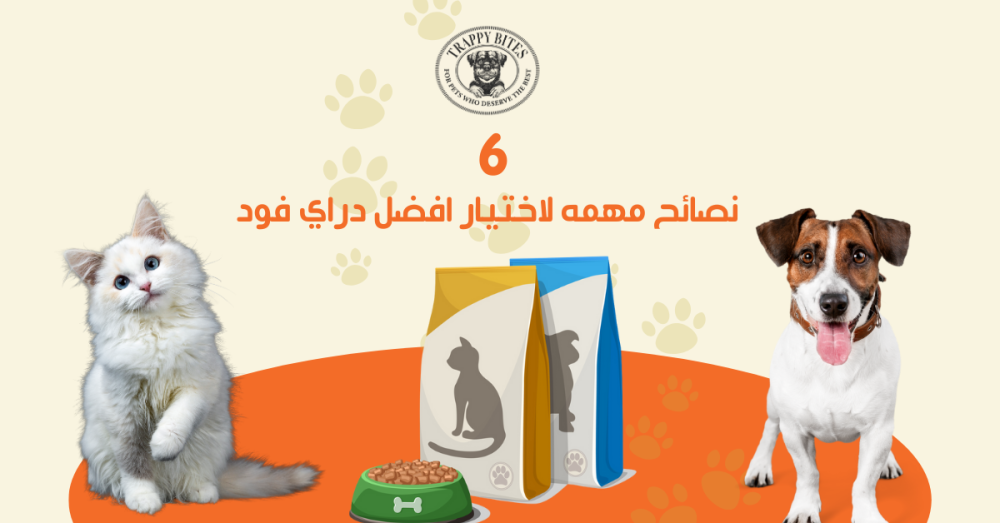Pet nutrition depends largely on the quality of the dry food you feed them. Choosing healthy dog food and ideal cat meals requires a thorough knowledge of the ingredients and an understanding of their impact on your pet’s health. In this article, we’ll review six key criteria to help you ensure you choose the best dry or wet food for your pet, contributing to their long-term health and happiness.

Read product ingredients carefully.
It is essential to understand and read between the lines when looking at the ingredients and analyzing any pet food product. This will help you determine if the product will fit your pet’s needs. For example, if a product is marketed as containing chicken and vegetables, it is important to make sure that these ingredients make up a significant part of the product and not just minor add-ons. Whether you are looking for cat treats or healthy dog food, the ingredients should be clear and specific.
The importance of arranging the components
In dry or wet pet food products, the ingredient list is arranged by the amount of each ingredient from largest to smallest. That is, if corn is listed as the first ingredient on the list, it means that corn is the most abundant ingredient in the product compared to the rest of the ingredients. As for salt, its percentage should not exceed 1% as a global standard in pet food.
Here are 6 basic steps to determine the quality of the product and its suitability for your pet:
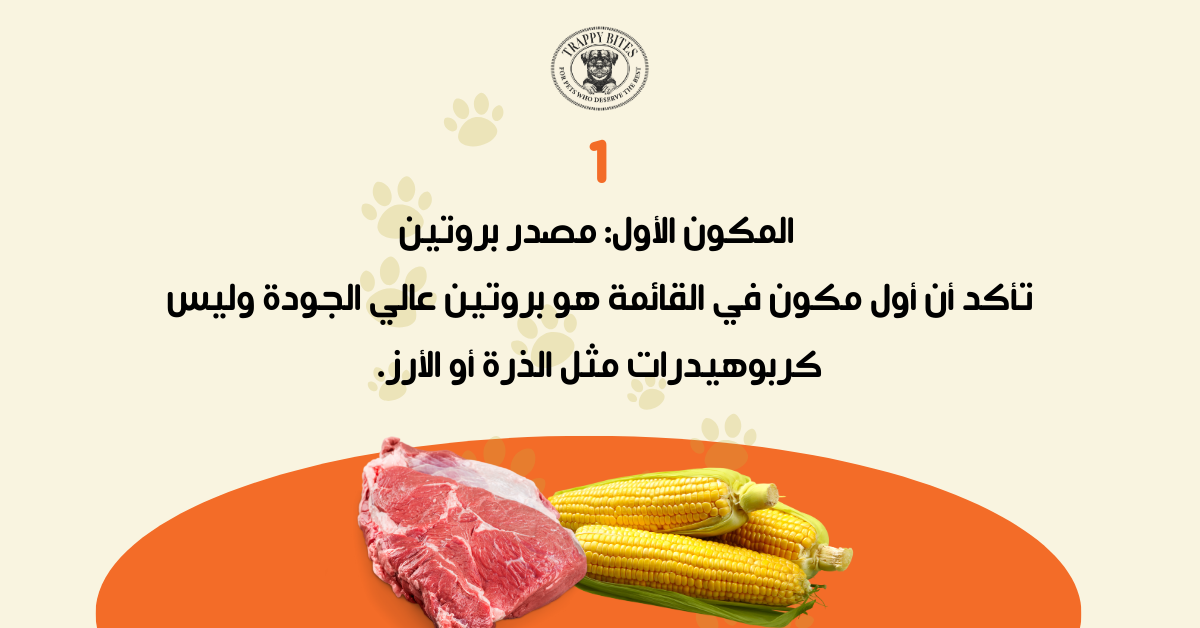
First, the first component: animal protein source
When choosing a food for your pet, it is important to pay attention to the first ingredient on the ingredient list. This ingredient should be a high-quality source of animal protein, such as chicken, beef, or fish. Animal proteins contain all the essential amino acids that your pet needs to build muscle and support effective immune system function. It is recommended to avoid dry foods that start with carbohydrate ingredients such as corn or rice, as these ingredients do not provide the same high nutritional value as animal proteins. Additionally, carbohydrates can be less effective in supporting your pet’s overall health and may be associated with weight gain if consumed in large amounts.
There are some tricks that you can be fooled by, no matter that the protein source is the highest percentage, by breaking down the carbohydrate source into small components, for example, you will find rice, rice bran, and ground rice, all of which are the same thing, but they have been broken down into small percentages so that the protein source is added first.
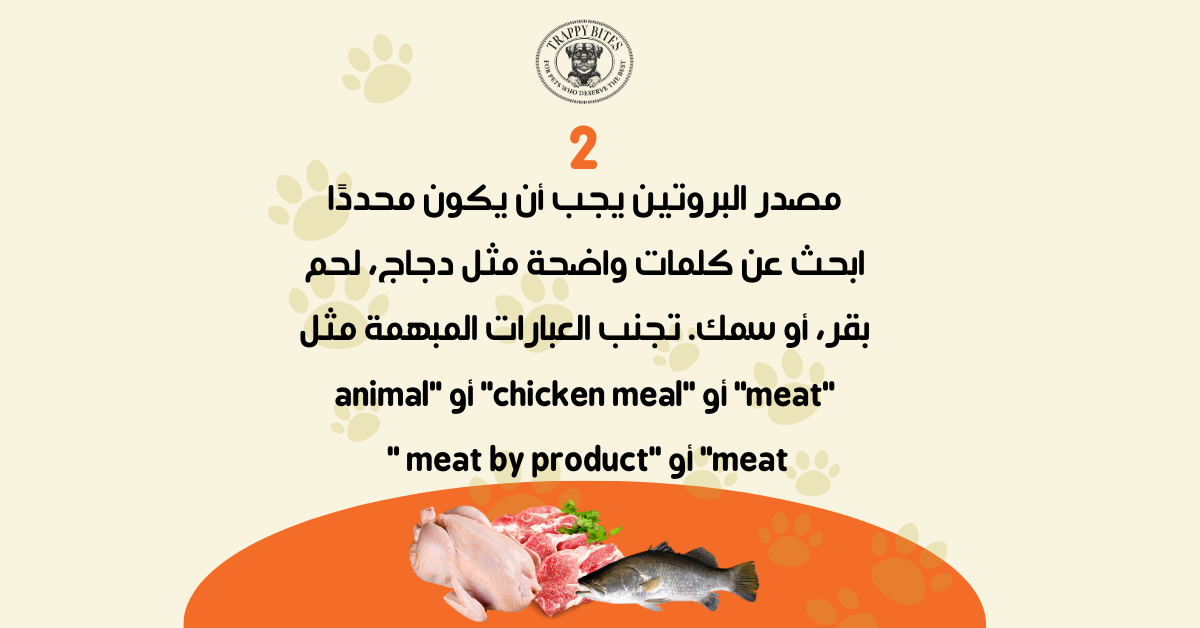
Second: The importance of accurately determining the source of protein
Being clear about the source of your protein is crucial when choosing a food for your pet. It’s best to look for specific names like “chicken,” “beef,” or “fish,” as these labels ensure that high-quality parts of the animal are used. By contrast, generic terms like “meat,” “chicken meal,” “animal meat,” or “meat by-product” are unreliable, as they indicate lower-quality ingredients that may include unidentified parts or animal by-products with low nutritional value.
Here are some definitions:
1. Chicken Meal:
Refers to chicken meat that has been dried and the fat and water removed, making it a concentrated source of protein. It can be of high quality if it is derived from muscle meat only. However, it may sometimes include other parts of the chicken such as bones.
2. Chicken By-Product:
Refers to the remaining parts of a chicken after the edible meat has been removed. This can include unwanted ingredients such as the neck, intestines, and other parts that are not as nutritionally valuable as pure meat. Similarly beef by product
3. Meat:
This term is vague and refers to meat from an unknown animal source. Because of its ambiguity, it can include different types of meat and sometimes even unidentified animal remains, making it less reliable.
4. Animal Meat
Like "meat," this term refers to meat of an animal of unknown origin. It may come from any type of animal, and therefore may include lower-quality or unknown parts. It is often used to refer to meat from animals that were "dead," "dying," "diseased," or "disabled" prior to slaughter. This meat is often of low quality and unsuitable for safe food consumption.
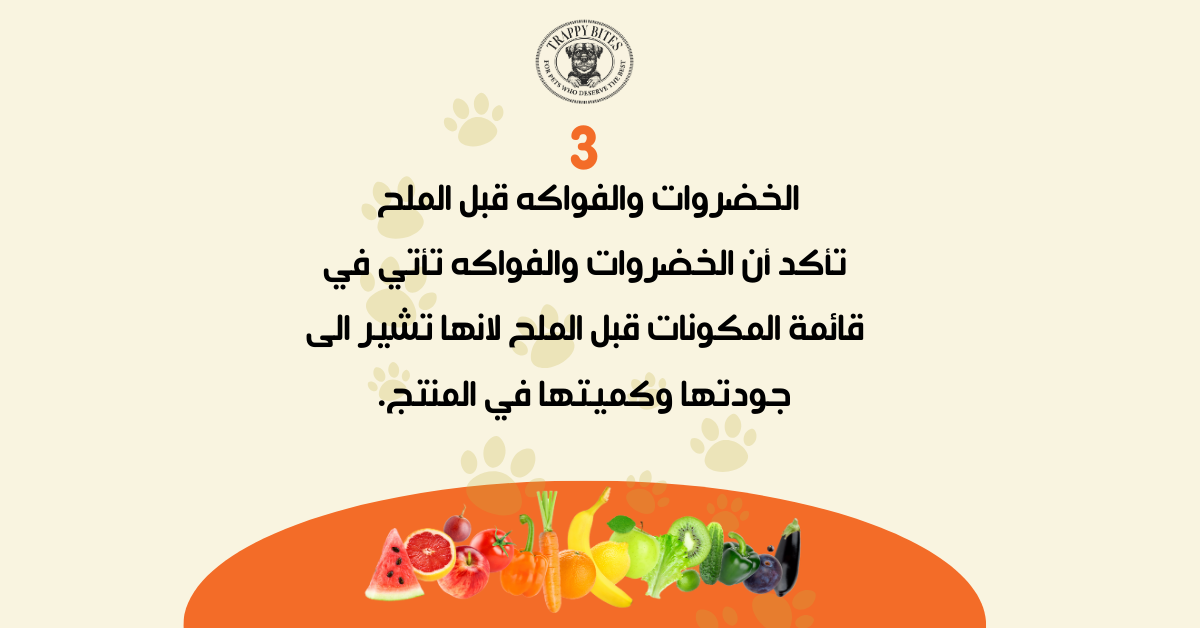
Third, when examining the list of ingredients in pet food, it is important to make sure that vegetables and fruits come before salt. This order indicates that these ingredients are present in greater quantities and therefore enhances the quality of the product. Vegetables and fruits provide a wide range of vitamins, minerals, and antioxidants that are essential for the health of cats and dogs. Including these ingredients in pet food helps support the immune system, improve digestion, and contribute to healthy skin and coat.
The importance of vegetables and fruits in the diet of cats and dogs is that they:
1. Rich source of vitamins and minerals:
Vegetables like carrots and sweet potatoes and fruits like berries provide vitamins like A and C, which play an important role in boosting the immune system and maintaining healthy eyes.
2. A source of dietary fiber:
The fiber found in vegetables and fruits helps improve digestive health by promoting good digestion and preventing constipation.
3. Antioxidants:
Some fruits, such as berries, contain powerful antioxidants that help fight oxidative damage to the body's cells, reducing the risk of chronic diseases.
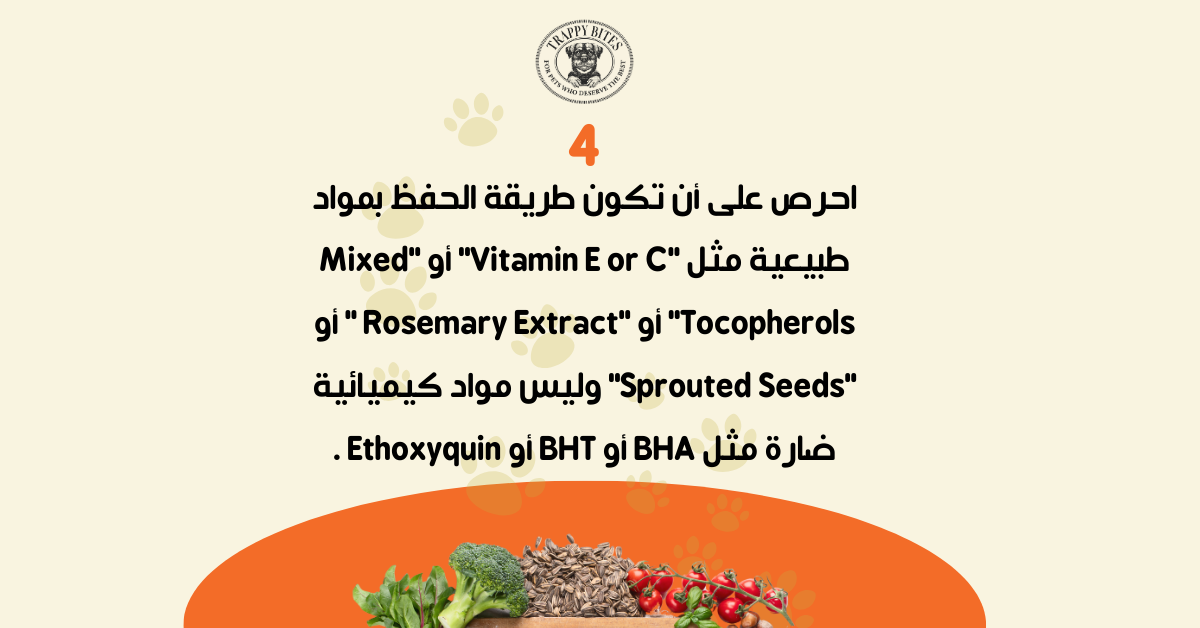
Fourth, it is essential to use natural preservatives to ensure the long-term health of your pet . Natural preservatives such as Vitamin E (or Mixed Tocopherols), Vitamin C, Rosemary Extract, and Sprouted Seeds are safe and effective options for maintaining food quality without the need for harmful chemicals.
In contrast, chemical preservatives such as BHA (Butylated Hydroxyanisole), BHT (Butylated Hydroxytoluene), and Ethoxyquin are commonly used to extend the shelf life of processed foods, but they are associated with health risks such as increased risk of cancer and liver toxicity. Scientific research has shown that these chemicals can cause negative health effects on pets when consumed over the long term, making it important to look for products that rely on natural preservatives.
Here's the difference between natural and chemical preservatives and how they affect your pet's health:
- Natural preservatives:
It has the ability to safely preserve the quality of food without causing harmful side effects. Vitamin E and C, along with rosemary extract, act as natural antioxidants that protect fats and oils in food from oxidation, thus preventing its quality from deteriorating.
- Chemical preservatives:
While they are effective in extending the shelf life of processed foods, their continued use can lead to their buildup in your pet’s body, increasing the likelihood of long-term health problems such as cancer and liver damage. Research has shown that these chemicals may be carcinogenic or cause damage to liver cells over time.
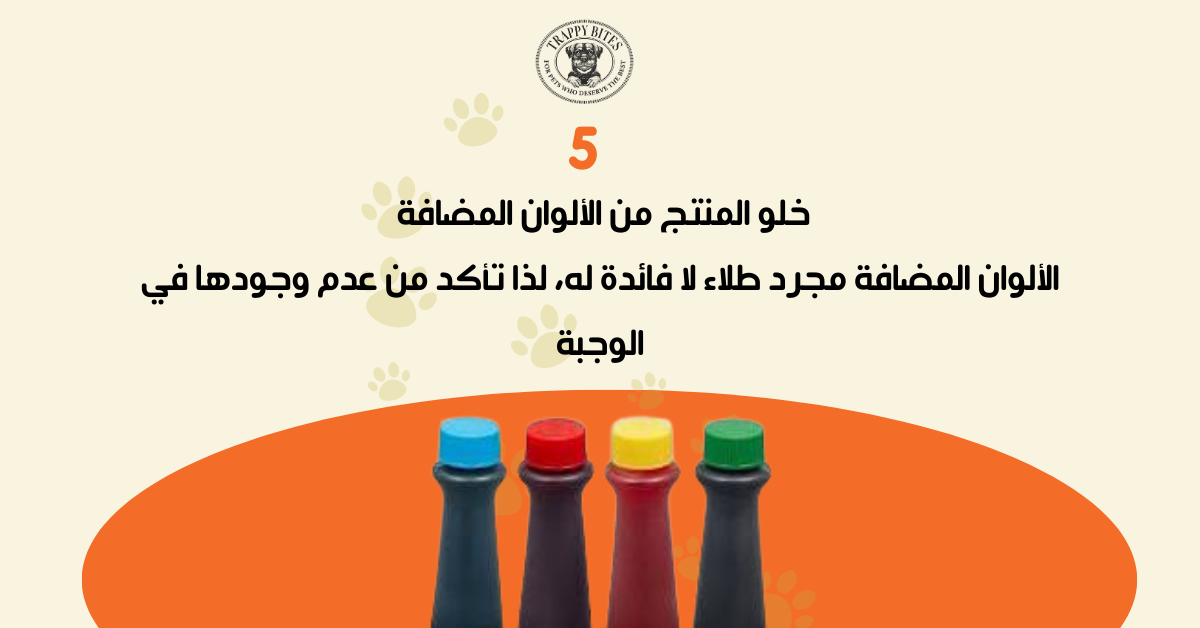
Fifth, avoid added colors in pet food.
Added colors in pet food have no nutritional value; they are simply used to enhance the appearance of the product in order to attract consumers’ attention. However, these colors can be harmful in the long run, especially if they contain artificial compounds that may cause allergic reactions or other health problems. Therefore, it is important to choose food products that are free of added colors to ensure the health and safety of your pet.
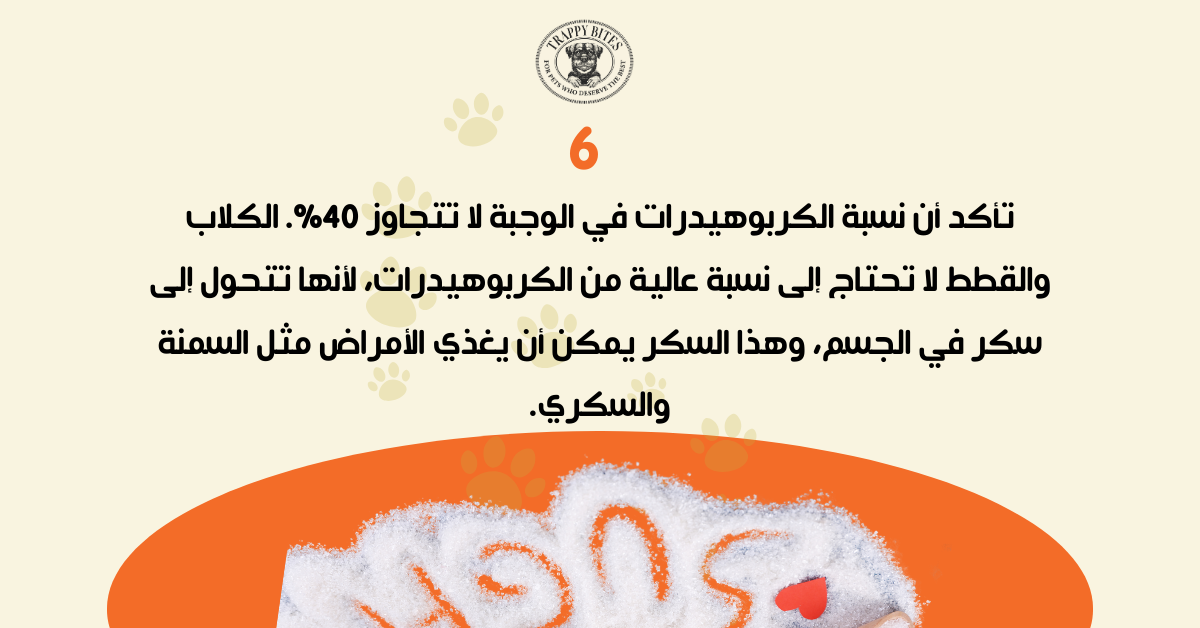
Finally, naturally, dogs and cats do not need large amounts of carbohydrates in their diet . Excess carbohydrates are converted to sugars in the body, which can lead to an increased risk of diseases such as obesity and diabetes. According to multiple nutritional studies, dry dog and cat foods should preferably contain less than 40% carbohydrates to maintain the health of the pet. Reducing carbohydrates helps maintain a healthy weight and reduces the risk of chronic diseases such as diabetes. Dogs and cats rely primarily on proteins and fats for energy, and large amounts of carbohydrates are not necessary and can be harmful in the long run.
The conclusion
Choosing a healthy dry food for your pet requires careful attention to the ingredients and how they are made. Protein should be the main and clearly identified ingredient, and the formula should include quality fruits and vegetables. Using natural preservatives and no added colors ensures a safe and healthy meal. Finally, keeping the carbohydrate content low helps protect your pet from diseases related to diabetes and obesity. Choosing a dry food wisely will contribute to your pet’s long-term health and happiness.
Trappy Bites meals are an ideal choice because they are a balanced mix of rich animal proteins (chicken and beef), fresh vegetables and fruits, giving your pet energy and optimal health. Completely free of chemicals and artificial preservatives, our meals are stored in the freezer to ensure freshness and superior quality. Choose Trappy Bites to provide delicious and nutritious meals that promote your pet's health and make every meal a fun and safe experience
the reviewer
1. Pet Food Institute. "Understanding Pet Food Labels: Ingredient Lists and Guaranteed Analysis." Available at: [https://www.petfoodinstitute.org](https://www.petfoodinstitute.org)
2. Association of American Feed Control Officials (AAFCO). "Pet Food Labeling Guide." Available at: [https://www.aafco.org](https://www.aafco.org)
3. Fascetti, AJ, & Delaney, SJ (2012). “Applied Veterinary Clinical Nutrition.” Wiley-Blackwell.
4.National Research Council (2006). "Nutrient Requirements of Dogs and Cats." The National Academies Press. Available at: [https://www.nap.edu](https://www.nap.edu)
5. Case, LP, Daristotle, L., Hayek, MG, & Raasch, MF (2011). “Canine and Feline Nutrition: A Resource for Companion Animal Professionals.” 3rd Edition. Elsevier Health Sciences.
6. Pet Nutrition Alliance. “Understanding Pet Food Labels and Marketing Claims.” Available at: [https://www.petnutritionalliance.org](https://www.petnutritionalliance.org)
7. Halliwell, B., & Gutteridge, J. M. C. (2015). "Free Radicals in Biology and Medicine." Oxford University Press.
8.World Health Organization (WHO). “Evaluation of Certain Food Additives and Contaminants: Sixty-seventh Report of the Joint FAO/WHO Expert Committee on Food Additives.” (2006). Available at: [https://www.who.int](https://www.who.int)
9. European Food Safety Authority (EFSA). “Scientific Opinion on the Re-evaluation of Certain Food Colours.” EFSA Journal (2010). Available at: [https://www.efsa.europa.eu](https://www.efsa.europa.eu)
10. Center for Science in the Public Interest (CSPI). “Food Dyes: A Rainbow of Risks.” (2010). Available at: [https://www.cspinet.org](https://www.cspinet.org)
11. Zoran, DL (2002). “The carnivore connection to nutrition in cats.” Journal of the American Veterinary Medical Association, 221(11), 1559-1567.
12. Laflamme, D. P. (2006). "Nutritional care for aging cats and dogs." Veterinary Clinics of North America: Small Animal Practice, 36(6), 1283-1297.
13. Association of American Feed Control Officials (AAFCO). “Pet Food Ingredient Lists: Why Protein Matters.” Available at: [https://www.aafco.org](https://www.aafco.org)

